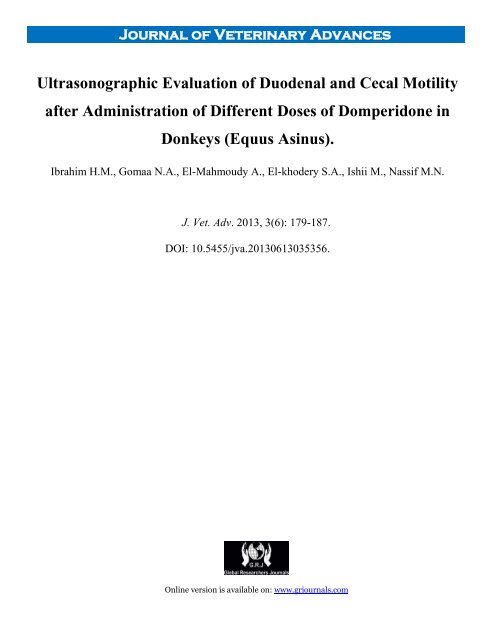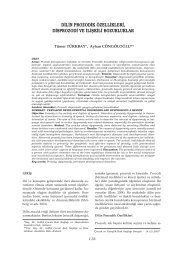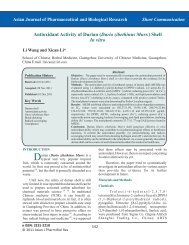Ultrasonographic Evaluation of Duodenal and ... - eJManager.com
Ultrasonographic Evaluation of Duodenal and ... - eJManager.com
Ultrasonographic Evaluation of Duodenal and ... - eJManager.com
Create successful ePaper yourself
Turn your PDF publications into a flip-book with our unique Google optimized e-Paper software.
Journal <strong>of</strong> Veterinary Advances<br />
<strong>Ultrasonographic</strong> <strong>Evaluation</strong> <strong>of</strong> <strong>Duodenal</strong> <strong>and</strong> Cecal Motility<br />
after Administration <strong>of</strong> Different Doses <strong>of</strong> Domperidone in<br />
Donkeys (Equus Asinus).<br />
Ibrahim H.M., Gomaa N.A., El-Mahmoudy A., El-khodery S.A., Ishii M., Nassif M.N.<br />
J. Vet. Adv. 2013, 3(6): 179-187.<br />
DOI: 10.5455/jva.20130613035356.<br />
Online version is available on: www.grjournals.<strong>com</strong>
ISSN: 2251-7685<br />
IBRAHIM ET AL.<br />
Original Article<br />
<strong>Ultrasonographic</strong> <strong>Evaluation</strong> <strong>of</strong> <strong>Duodenal</strong> <strong>and</strong> Cecal<br />
Motility after Administration <strong>of</strong> Different Doses <strong>of</strong><br />
Domperidone in Donkeys (Equus Asinus).<br />
1 Ibrahim H.M., 2 Gomaa N.A., 3 El-Mahmoudy A., 1 El-khodery S.A., 4 Ishii M., 2 Nassif<br />
M.N.<br />
1 Department <strong>of</strong> Internal Medicine <strong>and</strong> Infectious Diseases, Faculty <strong>of</strong> Veterinary Medicine, Mansoura University, Mansoura 35516,<br />
Egypt.<br />
2 Department <strong>of</strong> Animal Medicine, Faculty <strong>of</strong> Veterinary Medicine, Kafr Elsheikh University, Kafrelsheikh, Egypt.<br />
3 Department <strong>of</strong> Pharmacology, Faculty <strong>of</strong> Veterinary Medicine, Benha University, 13736 Moshtohor, Egypt.<br />
4 Large Animal Medicine Research Unit, Research Center for Animal Hygiene <strong>and</strong> Food Safety, Obihiro University <strong>of</strong> Agriculture <strong>and</strong><br />
Veterinary Medicine. 2-11 Nishi, Inada-cho, Obihiro, Hokkaido, 080-8555, Japan.<br />
Abstract<br />
The objective <strong>of</strong> the present study was to evaluate the effect <strong>of</strong> different doses <strong>of</strong> domperidone on duodenal<br />
<strong>and</strong> cecal motility in donkeys. Six adult donkeys (n = 6) were used in a crossover study. Domperidone was<br />
administered orally via nasogastric tube at a dose rate <strong>of</strong> 0.5, 1 <strong>and</strong> 2 mg kg -1 . <strong>Duodenal</strong> <strong>and</strong> cecal contractions<br />
were evaluated by ultrasonography using a 5 MHz curved-linear transducer. Examinations were performed<br />
before administration <strong>and</strong> at 15, 30, 60, 120 <strong>and</strong> 180 minutes post-administration. There was a significant (p<<br />
0.05) increase <strong>of</strong> duodenal contractions after 15 minutes <strong>of</strong> domperidone administration at 1 mg kg -1 <strong>and</strong> lasted<br />
until 60 minutes. The cecal contractions were also significantly increased after 15 minutes <strong>and</strong> lasted until 60<br />
minutes at a dose rate <strong>of</strong> 1 <strong>and</strong> 2 mg kg -1 (MANOVA fit, p< 0.01; Wilks, Lambda for dose × time interaction, p<br />
< 0.05). The results <strong>of</strong> the present study indicate that 1 mg kg -1 domperidone is the most effective prokinetic<br />
dose on duodenal <strong>and</strong> cecal contraction. Domperidone may be an alternative prokinetic drug for intestinal <strong>and</strong><br />
cecal disorders in equines.<br />
Key words: Domperidone, Duodenum, Caecum, Ultrasonography, Donkeys.<br />
Corresponding author: Department <strong>of</strong> Internal Medicine <strong>and</strong> Infectious Diseases, Faculty <strong>of</strong> Veterinary Medicine, Mansoura University, Mansoura 35516, Egypt.<br />
Received on: 11 Jun 2013.<br />
Revised on: 20 Jun 2013.<br />
Accepted on: 22 Jun 2013.<br />
Online Published on: Jun 2013.<br />
179 J. Vet. Adv., 2013, 3(6): 179-187.
ULTRASONOGRAPHIC EVALUATION OF DUODENAL AND CECAL …<br />
Introduction<br />
Abdominal pain in equines is produced by gas <strong>and</strong><br />
fluid accumulation from the alteration in gastrointestinal<br />
tract motility (Koenig <strong>and</strong> Cote, 2006).<br />
Paralytic ileus is a functional inhibition <strong>of</strong><br />
propulsive intestinal motility. Ileus can occur either<br />
from local diseases involving digestive system or a<br />
consequence <strong>of</strong> systemic illness (Adams 1988,<br />
Lester 2002).<br />
Large colon impaction is more <strong>com</strong>mon <strong>and</strong><br />
constitutes the most cause <strong>of</strong> simple obstruction in<br />
horses especially in left ventral colon, pelvic flexure<br />
<strong>and</strong> right dorsal colon (Grosche 2000). The exact<br />
causes <strong>and</strong> pathogenesis <strong>of</strong> impactions are not fully<br />
understood until now. Parasitic infestation or<br />
migration, motility disorders, dental abnormalities,<br />
dietary or management factors, <strong>and</strong> reduced water<br />
intake are <strong>of</strong>ten implicated (Sullins 1990).<br />
Prokinetic agents are those drugs, which promote<br />
gastrointestinal motility either by increasing the<br />
frequency or strength <strong>of</strong> contraction, but without<br />
changing their rhythm (Hardman et al., 2001).<br />
They are useful in treatment <strong>of</strong> motility disorders in<br />
humans <strong>and</strong> animals <strong>and</strong> used to relieve<br />
gastrointestinal symptoms such as abdominal<br />
dis<strong>com</strong>fort, bloat <strong>and</strong> constipation (Hardman et al.,<br />
2001).<br />
Domperidone is a selective peripheral dopamine<br />
antagonist (DA2 receptor) <strong>and</strong> a novel<br />
gastroprokinetic lacking central side-effect. Due to<br />
its blocking activity on peripheral dopamine<br />
receptors, domperidone can enhance effectively<br />
esophageal peristalsis, lower esophageal pressure,<br />
gastric motility, <strong>and</strong> gastro-duodenal coordination<br />
<strong>and</strong> consequently improve gastric emptying <strong>and</strong><br />
decrease small bowel transit time (Lester 2002).<br />
Studies in animals <strong>and</strong> man have shown that<br />
domperidone enhances the peristaltic contractions<br />
<strong>of</strong> the esophageal body, increase the muscle tone <strong>of</strong><br />
the lower esophageal sphincter, <strong>and</strong> stimulate<br />
gastric motor activity (Kilbinger <strong>and</strong> Weihrauch<br />
1982). So, it has been found to be beneficial in the<br />
treatment <strong>of</strong> gastric motor failure <strong>and</strong> <strong>of</strong> reflux<br />
esophagitis secondary to lower esophageal sphincter<br />
in<strong>com</strong>petence (Kilbinger <strong>and</strong> Weihrauch 1982).<br />
The prokinetic effect <strong>of</strong> domperidone in equines<br />
have not been described sufficiently. Consequently,<br />
the purpose <strong>of</strong> the present study was to evaluate the<br />
effect <strong>of</strong> different doses <strong>of</strong> domperidone on the<br />
motility <strong>of</strong> the small intestine <strong>and</strong> caecum in<br />
donkeys using transcutaneous ultrasonography.<br />
Materials <strong>and</strong> Methods<br />
Study Overview <strong>and</strong> Animals<br />
Six adult healthy donkeys (Equus asinus) were<br />
used in a crossover study. The age <strong>of</strong> donkeys<br />
ranged from 9 to 17 years <strong>and</strong> body weight (B.W.)<br />
ranged from 100 to 220 kg. None <strong>of</strong> those donkeys<br />
had gastrointestinal disorders or evidence <strong>of</strong><br />
systemic diseases based on thorough clinical<br />
examination (Kelly, 1984). Two weeks before<br />
starting the study, each donkey was stabled on<br />
straw-bedded boxes <strong>and</strong> fed twice a day with 1 kg<br />
chopped hay/100 kg B.W. <strong>and</strong> 0.5 kg concentrate<br />
with unlimited access to water. This study was<br />
carried out at Department <strong>of</strong> Animal Medicine,<br />
Faculty <strong>of</strong> Veterinary Medicine, Kafr Elsheikh<br />
University, Egypt. These trials were approved by<br />
Animal welfare <strong>and</strong> Ethics Committee, Faculty <strong>of</strong><br />
Veterinary Medicine, Kafr-Elsheikh University.<br />
Protocol <strong>of</strong> the Study<br />
Each donkey underwent four trials. The first trial<br />
was carried out by counting the intestinal<br />
contractions at descending duodenum <strong>and</strong> cecal<br />
body before <strong>and</strong> after oral administration <strong>of</strong> 1000<br />
ml <strong>of</strong> clean water via a nasogastric tube (control<br />
group). The second, third <strong>and</strong> fourth trials included<br />
the counting <strong>of</strong> intestinal contractions at the same<br />
regions <strong>of</strong> the intestine before <strong>and</strong> after oral<br />
administration <strong>of</strong> Dompridone (Motilium ® ,<br />
Miapharm, under licence <strong>of</strong> Janssen Pharmaceutica,<br />
Janssen-cilag, Belgium), at a dose rate <strong>of</strong> 0.5, 1 <strong>and</strong><br />
2 mg kg -1 , respectively (treated groups). The dose<br />
rate was selected based on that reported by the<br />
Merck veterinary manual. Domperidone was<br />
dissolved in 1000 ml <strong>of</strong> clean water <strong>and</strong><br />
administered via nasogastric tube. The washout<br />
period between the experiments was one<br />
week. Intestinal contractions were counted in a<br />
control <strong>and</strong> treated groups one hour after feeding.<br />
They were counted over a period <strong>of</strong> 3 minutes<br />
before treatment <strong>and</strong> at 15, 30, 60, 120 <strong>and</strong> 180<br />
minutes post-treatment. During the monitoring<br />
periods, there was no access to food or water. In<br />
addition, any evidence <strong>of</strong> adverse effects was<br />
observed during the monitoring period following<br />
the administration <strong>of</strong> dompridone.<br />
180 J. Vet. Adv., 2013, 3(6): 179-187.
IBRAHIM ET AL.<br />
<strong>Ultrasonographic</strong> Examination<br />
Transcutaneous ultrasonographic examinations<br />
were performed for counting the intestinal<br />
contractions at the descending duodenum <strong>and</strong> the<br />
body <strong>of</strong> cecum (Kirberger et al., 1995, Freeman<br />
2002, Mitchell et al. 2005, Gomaa et al., 2011).<br />
The donkeys were restrained in stocks without any<br />
sedation during the ultrasonographic examinations.<br />
The position <strong>of</strong> the descending duodenum <strong>and</strong> cecal<br />
body in each donkey was identified before the<br />
beginning <strong>of</strong> ultrasonographic examinations. The<br />
descending duodenum was located at the right<br />
thoracic area extending from the 8th to the 18th rib<br />
along the line joining the olecranon <strong>and</strong> tuber<br />
coxae. The cecal body was identified in the upper<br />
part <strong>of</strong> the right para-lumbar region. The abdomen<br />
was clipped at those identified regions, cleaned with<br />
alcohol <strong>and</strong> then coupling gel was applied to<br />
enhance the contact with the probe. Abdominal<br />
ultrasonographic examination was performed with a<br />
5 MHz curved-linear transducer (CHISON Digital<br />
Color Doppler Ultrasound system, iVis 60 EXPERT<br />
VET, CHISON Medical Imaging Co., Ltd). The<br />
transducer was oriented in a longitudinal direction<br />
for better visualizing the sacculations <strong>of</strong> cecum <strong>and</strong><br />
left ventral colon. In contrast to the gas-filled cecal<br />
base <strong>and</strong> movable cecal apex, the cecal body wall is<br />
easy to identify based on the cecal body fluid<br />
content. The transducer was positioned in a crosssectional<br />
direction for the best visualization <strong>of</strong> the<br />
descending duodenum. Once the optimal imaging<br />
plane had been determined, the intestinal<br />
contractions were counted during a 3-minute period<br />
<strong>and</strong> assessed by the movement <strong>of</strong> intestinal wall <strong>and</strong><br />
luminal contents. In the descending duodenum, the<br />
numbers <strong>of</strong> duodenal distensions or circular<br />
contractions were counted. The contractions <strong>of</strong> the<br />
cecal body were associated with deviation <strong>of</strong> cecal<br />
wall from the transducer <strong>of</strong> more than 2 cm.<br />
Nevertheless, the contractions <strong>of</strong> left ventral colon<br />
were assessed by changes in its sacculations.<br />
In all trials, the intestinal contractions counting<br />
were done after one hour <strong>of</strong> feeding at 9:00 AM <strong>and</strong><br />
were carried out by the same person <strong>and</strong> revised<br />
again by two persons to avoid any individual<br />
variations.<br />
Statistical Analysis<br />
Data analyses were performed using a<br />
statistical s<strong>of</strong>tware program (GMP for windows<br />
Version 5.1; SAS Institute, Cary, NC, USA). Data<br />
were tested for normal distribution using<br />
D’Agostino <strong>and</strong> Pearson omnibus normality test.<br />
The data were normally distributed; therefore, mean<br />
<strong>and</strong> st<strong>and</strong>ard deviation for each assessed treatment<br />
at each time point was calculated. Repeated<br />
measures MANOVA (repeated measures on dose<br />
<strong>and</strong> time) were used to determine the main effect <strong>of</strong><br />
dose <strong>and</strong> time. Wilks’ Lambda test was selected to<br />
evaluate within group interactions <strong>and</strong> evidence <strong>of</strong><br />
time x group interactions. Where Wilks’ Lambda<br />
test indicated a statistically significant difference<br />
between groups, one way ANOVA with Tukey-<br />
Kramer HSD post-hoc multiple <strong>com</strong>parison tests<br />
was used to identify which group was statistically<br />
different. Differences between means at p < 0.05<br />
were considered significant.<br />
Results<br />
The descending duodenum was constantly<br />
observed at 12th -13th intercostal space. It was<br />
visualized between the liver <strong>and</strong> the right dorsal<br />
colon as an oval to round shape (Figure 1 <strong>and</strong> 2).<br />
During ultrasonographic examination, segmental<br />
contractions were noticed.<br />
The cecal body wall appeared as a mobile<br />
hypoechoic line overlying a hyperechoic gas<br />
shadow adjacent to the right abdominal wall (Figure<br />
3). The normal cecal motility <strong>com</strong>prised either<br />
localized segmental contractions (mixing) or<br />
propagating (propulsive) contractions in both<br />
forward <strong>and</strong> backward directions. The segmental<br />
contraction <strong>of</strong> cecum was measured by moving the<br />
cecal body wall away from abdominal wall about 2<br />
cm (Figure 4). Only the segmental contractions<br />
were counted during ultrasonographic examination<br />
<strong>of</strong> descending duodenum <strong>and</strong> body <strong>of</strong> cecum.<br />
In control group, mean <strong>and</strong> st<strong>and</strong>ard deviation <strong>of</strong><br />
the recorded pre-administration intestinal<br />
contractions at the descending duodenum <strong>and</strong> cecal<br />
body were 6.7 ± 1.0 <strong>and</strong> 4.0 ± 0.9 contractions / 3<br />
minutes, respectively. There was non-significant<br />
difference <strong>of</strong> duodenal or cecal contractions during<br />
a three-hours monitoring period after clean water<br />
administration.<br />
The duodenal contractions were increased<br />
significantly (MANOVA fit, p< 0.01; Wilks,<br />
181 J. Vet. Adv., 2013, 3(6): 179-187.
ULTRASONOGRAPHIC EVALUATION OF DUODENAL AND CECAL …<br />
Lambda test for dose × time interaction, p
IBRAHIM ET AL.<br />
Fig.3. Ultrasound scan <strong>of</strong> cecum. It appears adjacent to body wall at the most upper part <strong>of</strong> picture. The cecal body wall<br />
(B) appears as hypoechoic line over lining a hyperechoic line <strong>of</strong> mucosa with multi-hyperechoic lines (reverberation<br />
artifact) <strong>and</strong> hypoechoic area at the distal part <strong>of</strong> picture (A) representing the food <strong>and</strong> fluid in cecum.<br />
Fig.4. Ultrasound scan <strong>of</strong> cecum during mixing contraction. The cecal body wall (B) moves away the abdominal wall<br />
about 2 cm which representing the mixing contraction. A hypoechoic area at the distal part <strong>of</strong> picture (A) representing the<br />
food <strong>and</strong> fluid in cecum.<br />
183 J. Vet. Adv., 2013, 3(6): 179-187.
ULTRASONOGRAPHIC EVALUATION OF DUODENAL AND CECAL …<br />
Fig.5. <strong>Duodenal</strong> contractions (number/3minutes) after administration <strong>of</strong> different doses <strong>of</strong> domperidone in donkeys.<br />
184 J. Vet. Adv., 2013, 3(6): 179-187.
IBRAHIM ET AL.<br />
Fig.6. Cecal contractions (number/3minutes) after administration <strong>of</strong> different doses <strong>of</strong> domperidone in donkeys.<br />
Discussion<br />
Domperidone is a unique gastroprokinetic drug<br />
because <strong>of</strong> its safety pr<strong>of</strong>ile in human; it appears to<br />
be alternative to metoclopramide (Barone 1999). In<br />
a preliminary study using an experimental model <strong>of</strong><br />
post-operative ileus in ponies; domperidone was<br />
effective in restoring transit time, electromechanical<br />
activity, <strong>and</strong> coordination <strong>of</strong> gastric <strong>and</strong> intestinal<br />
cycles at a dose rate <strong>of</strong> 0.2 mg kg-1 intravenously<br />
(Gerring <strong>and</strong> King 1989). No further information<br />
about domperidone as a gastroprokinetic agent in<br />
equines; therefore, the present study was<br />
constructed to evaluate the effect <strong>of</strong> domperidone<br />
on both the duodenal <strong>and</strong> cecal contractions in<br />
donkeys via ultrasonography.<br />
In the present study, oral administration <strong>of</strong><br />
domperidone at a dose rate 1 mg kg -1 produced a<br />
rapid significant increase in duodenal motility after<br />
15 minutes post-administration. This could be<br />
attributed to the fact that the absorption <strong>of</strong><br />
185 J. Vet. Adv., 2013, 3(6): 179-187.<br />
domperidone solution was very rapid, with mean<br />
peak plasma concentration attained at 0.6 hour (ten<br />
minutes) after its oral administration (Huang et al.,<br />
1986).<br />
The increase <strong>of</strong> duodenal contractions was<br />
attributed to the stimulatory effect <strong>of</strong> domperidone<br />
on gastrointestinal muscle itself as well as on the<br />
cholinergic neurons/receptors in the gastrointestinal<br />
wall (Nakayama et al., 1979, Li et al., 2009).<br />
The prokinetic effect <strong>of</strong> domperidone is likely a<br />
result <strong>of</strong> block <strong>of</strong> D2 inhibitory receptors. It has<br />
been shown to increase lower esophageal sphincter<br />
pressure, improve antro-duodenal co-ordination <strong>and</strong><br />
gastric emptying <strong>and</strong> normalize gastric<br />
dysrhythmias (Koch et al., 1989, Prakash <strong>and</strong><br />
Wagstaff 1998). Consequently, domperidone may<br />
improve antral <strong>and</strong> duodenal contraction by<br />
dopaminergic antagonism in the myenteric plexus<br />
similar to metoclopramide but it does not possess<br />
the serotonin effect <strong>of</strong> metoclopramide <strong>and</strong><br />
cisapride (Barone 1999).
ULTRASONOGRAPHIC EVALUATION OF DUODENAL AND CECAL …<br />
In a study conducted on dogs, domperidone was<br />
found to enhance the gastric body <strong>and</strong> antrum<br />
motility (Shuto et al., 1980). The enhancement<br />
pattern <strong>of</strong> gastric body motility did not last so long<br />
<strong>and</strong> showed an increase in tone <strong>of</strong> contraction. The<br />
authors reported that the augmentation <strong>of</strong> the gastric<br />
motility by domperidone was observed even after<br />
vagotomy <strong>and</strong> splanchnicotomy, but it was weaker<br />
<strong>and</strong> shorter than that in the intact state. Therefore, it<br />
was reported that domperidone activates the gastric<br />
motility not only by central mechanism, but also by<br />
stimulation <strong>of</strong> intramural neurons.<br />
Domperidone improves gastric emptying <strong>of</strong><br />
liquids <strong>and</strong> solids by an inhibition <strong>of</strong> adaptive<br />
fundic relaxation, an increase in antral contractility<br />
<strong>and</strong> improvement <strong>of</strong> antro-duodenal coordination<br />
(Johnson 1992). The prokinetic effect <strong>of</strong><br />
domperidone on the cecal contraction began after<br />
15 minutes <strong>of</strong> administration <strong>of</strong> 1 mg kg-1 <strong>and</strong> had<br />
the same effect <strong>of</strong> 2 mg kg-1, while, 0.5 mg kg-1<br />
did not have any significant effect during<br />
monitoring period. This could be attributed to the<br />
effect <strong>of</strong> domperidone as D2 receptor antagonists<br />
such as metoclopramide which has shown to<br />
increase gastric emptying, <strong>and</strong> mouth-tocecum<br />
transit time in human (Kirby et al., 1989).<br />
On the contrary, high doses <strong>of</strong> metoclopramide (D2<br />
receptor antagonist) had weak <strong>and</strong> unspecific<br />
stimulatory motor effects at the equines ileo-caecocolonic<br />
junction (Ruckebusch <strong>and</strong> Roger 1988).<br />
Generally, limited studies on D2 receptor<br />
antagonists on cecal contractions in equine are<br />
available <strong>and</strong> mechanism <strong>of</strong> action is not explained.<br />
The present study in the first report provides a<br />
preliminary result about the effect <strong>of</strong> domperidone<br />
on the cecal motility in donkeys.<br />
Conclusion<br />
Domperidone at a dose rate <strong>of</strong> 1 mg kg-1<br />
promotes duodenal <strong>and</strong> cecal contractions in<br />
conscious donkeys without any adverse effects.<br />
Consequently, domperidone may be an alternative<br />
safe prokinetic in equines. However, the findings <strong>of</strong><br />
the present study in healthy donkeys may not be<br />
extrapalatable to findings in donkeys <strong>and</strong> horses<br />
with GIT dysfunction. Therefore, further studies<br />
need to be done on diseased cases related to the<br />
clinical practice.<br />
Conflict <strong>of</strong> interest statement<br />
The authors have indicated that they have no<br />
financial involvement with any organization or<br />
entity with a financial interest in, or in financial<br />
<strong>com</strong>petition with, the subject matter or materials<br />
discussed in this article.<br />
References<br />
Adams SB (1988). Recognition <strong>and</strong> management <strong>of</strong> ileus.<br />
Veterinary Clinic North American Equine Practice 4, 91-<br />
104.<br />
Barone JA (1999). Domperidone: a peripherally acting<br />
dopamine2-receptor antagonist. The Annals <strong>of</strong><br />
Pharmcotherap., 33, 429-440.<br />
Freeman LS (2002). Ultrasonography <strong>of</strong> the equine abdomen:<br />
Techniques <strong>and</strong> normal findings. In Practice 24, 204-211.<br />
Gerring EL, (King JN 1989). Cisapride in the prophylaxis <strong>of</strong><br />
equine post operative ileus. Equine. Vet. J. Supplment 7, 52-<br />
55.<br />
Gomaa N, Uhlig A, (Schusser GF 2011). Effect <strong>of</strong> Buscopan<br />
<strong>com</strong>positum on the motility <strong>of</strong> the duodenum, cecum <strong>and</strong><br />
left ventral colon in healthy conscious horses. Berl. Munch<br />
Tierarztl Wochenschr., 124, 168-174.<br />
Grosche A (2000). Kolik bei Pferden-Retrospektive Studie aus<br />
dem Patientengut der Medizinischen Tierklinik Leipzig<br />
1994-1998 [Dissertation med.vet]. Leipzig 2000: Univ.<br />
Leipzig. (Article in German).<br />
Hardman JG, Limbird LE, (Gilman AG 2001). Goodman &<br />
Gilman's. The Pharmacological Basis <strong>of</strong> Therapeutics. 10th<br />
ed. New York: McGraw-Hill.<br />
Huang YC, Colaizzi JL, Bierman RH, Woestenborghs R,<br />
Heykants JJ (1986). Pharmacokinetics <strong>and</strong> dose<br />
proportionality <strong>of</strong> domperidone in healthy volunteers. J.<br />
Clinic. Pharm. cology, 26, 628-632.<br />
Johnson AG (1992). Domperidone in the treatment <strong>of</strong><br />
gastroesophageal reflux disease. Frontiers <strong>of</strong><br />
gastrointestinal research 20, 45-53.<br />
Kelly WR (1984). The thorax. Textbook <strong>of</strong> Veterinary<br />
Clinical Diagnosis, 3rd ed, 143- 185.<br />
Kilbinger H, Weihrauch TR (1982). Drugs increasing<br />
gastrointestinal motility. Pharmacology 25, 61-72.<br />
Kirberger MR, van den Berg JS, Gottschalk RD, Guthrie AJ<br />
(1995). <strong>Duodenal</strong> ultrasonography in the normal adult horse.<br />
Vet. Radio. Ultrasound., 36, 50-56.<br />
Kirby MG, Dukes GE, Heizer WD, Bryson JC, (Powell JR<br />
1989). Effect <strong>of</strong> metoclopramide, bethanechol, <strong>and</strong><br />
loperamide on gastric residence time, gastric emptying, <strong>and</strong><br />
mouth-to-cecum transit time. Pharm. cotherap., 9, 226-231.<br />
Koch KL, Stern RM, Stewart WR, (Vesey MW 1989). Gastric<br />
emptying <strong>and</strong> gastric myoelectrical activity in patients with<br />
186 J. Vet. Adv., 2013, 3(6): 179-187.
IBRAHIM ET AL.<br />
diabetic gastroparesis: Effect <strong>of</strong> long-term domperidone<br />
treatment. Am. J. Gastroenter., 84, 1069-1075.<br />
Koenig J, (Cote N 2006). Equine gastrointestinal motility-ileus<br />
<strong>and</strong> pharmacological modification. Canadian. Vet. J., 47,<br />
551-555.<br />
Lester G (2002). Gastrointestinal Ileus. In: Large Animal<br />
Internal Medicine, Smith, B. (Ed.). Mosby, St. Louis, p.<br />
674-679.<br />
Li F, Zou Y, (Huang T (2009). Effect <strong>of</strong> prokinetic agents on<br />
the electrical activity <strong>of</strong> stomach <strong>and</strong> duodenum in rats.<br />
Zhong Nan Da Xue Xue Bao Yi Xue Ban 34, 599-602.<br />
Mitchell CF, Malone ED, Sage AM, (Niksich K 2005).<br />
<strong>Evaluation</strong> <strong>of</strong> gastrointestinal activity in healthy horses<br />
using B mode <strong>and</strong> Doppler ultrasonography. Canadian. Vet.<br />
J., 46, 134-140.<br />
Nakayama S, Neya T, Yamasato T, Takaki M, (Mizutani M<br />
1979). Effects <strong>of</strong> domperidone on gastrointestinal <strong>and</strong><br />
gallbladder motility <strong>and</strong> gastric emptying (author’s transl).<br />
Nihon Heikatsukin Gakkai Zasshi., 15, 327-335.<br />
Prakash A, (Wagstaff AJ 1998). Domperidone. A review <strong>of</strong> its<br />
use in diabetic gastropathy. Drugs., 56, 429-445.<br />
Ruckebusch Y, (Roger DT 1988). Prokinetic effects <strong>of</strong><br />
cisapride, naloxone <strong>and</strong> parasympathetic stimulation at the<br />
equine ileo-caeco-colonic junction. J. Vet. Pharm. Ther., 11,<br />
322-329.<br />
Shuto K, Shiozaki S, Kojima T, (Tanaka M 1980). Effects <strong>of</strong><br />
KW-5338 (domperidone) on gastric motility. J. Pharm.<br />
cobiodynamic., 3, 715-719.<br />
Sullins KE (1990). Diseases <strong>of</strong> the Large Colon. In: The<br />
Equine Acute Abdomen, White, N.A. (Ed.). Lea <strong>and</strong><br />
Febiger, Philadelphia, p. 375-391.<br />
187 J. Vet. Adv., 2013, 3(6): 179-187.
















